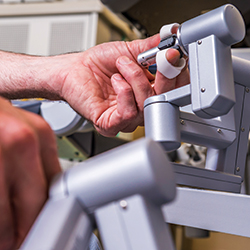
Game-changing virtual technology in the surgical trade.
While at a medical meeting in 2005, I came across a surgical device hidden at the end of an aisle in a large exhibit hall in Miami, Florida. There, a lone representative of the company was trying to entice gynecologic oncology surgeons like myself to take it for a “test drive.” It had the appearance of a futuristic computer station with an oversized view finder, and was intended to give the user a totally immersive environment in which to perform advanced surgical procedures.
I knew nothing of this device, despite it having been on the market since 1999 and just having been approved by the FDA for use in gynecologic procedures. Apparently, it had been used by urologists for radical prostatectomies (a surgical procedure to remove the prostate, usually performed for cancer treatment) and was reported to cause fewer complications and return patients to work more quickly than open surgery.
This was intriguing, to say the least. As I sat down to use the “robot,” it took me about three minutes to realize that using this for minimally invasive surgical procedures (commonly known as laparoscopy) was going to be a game-changer. The gestalt I experienced while manipulating the finger calipers at the console was remarkable. Here was a three-dimensional, high-definition, totally immersive, virtual surgical environment that allowed for complete translation of my movements into the “fingertips” of the robotic arms. This device was poised to become an integral part of how I performed extensive surgery to eliminate gynecologic cancers in the pelvis or abdomen without actually opening the abdomen. As I practiced with this new machine, I had no idea how much it would change patient care and how I practiced the art of my surgical trade. All I knew was that I needed to find a way to get the surgical robot to my hospital.
Implementing the Technology
Two years later, we found a way to convince our hospital leadership to invest in the technology. Although I was at a publicly-funded (county) hospital in Fort Worth, Texas, we felt the use of this technology could be advantageous to our patients by allowing us to perform precise cancer procedures such as radical hysterectomies, pelvic and aortic lymph node dissections, as well as other surgical staging without having to make a large incision in the abdominal wall.
Prior to implementing the device in my surgical practice, my open procedure rate was approximately 85 percent; only 10 to 15 percent were minimally invasive or with traditional laparoscopy. After just 18 months of use at that hospital in Texas, I had performed 207 cases with the robotic device. Most of these cases would have been performed through much larger openings in the abdominal wall. Patient outcomes with these larger incisions typically included a four-to-five day hospital stay, requiring narcotic pain management and 15- to 25-percent wound infection rates, especially in overweight and morbidly obese patients. There was also a higher risk for blood clots in the legs or lungs, and a much slower return to work or usual daily activities, typically requiring a six-to-eight week recovery period.
We were initially criticized by some for purchasing such expensive technology. However, we demonstrated that by modernizing our approach to surgery and investing in the robotic device, we actually lowered the surgical cost of gynecologic cancer care to our patients. We reduced length of stay in many cases to less than 24 hours, and our readmission rate, wound infection rates and blood clot rates were all significantly reduced. We also demonstrated improvement in the societal cost of surgical care by returning women back to work within two to four weeks on average.
Robotic Surgery in Peoria
Fast forward to 2014. Here in Peoria, I have been privileged to be part of the robotic surgery program at OSF Saint Francis Medical Center for the last five years. The surgeons of Peoria Surgical Group were forward-thinking when they invested in the da Vinci robotic platform in 2002. A few visionary surgeons—such as Dr. David Crawford and Dr. Dale Geiss—patiently, cautiously and artfully applied this new technology to the surgical care of their patients. That is what drew me from Texas to Peoria—the ability to work with surgeons like these, as well as the teaching and research opportunities through the University of Illinois College of Medicine at Peoria. Combining that environment with the strength of the OSF network and support of administrative leadership, this advanced technology continues to improve the quality of care to patients in central Illinois.
The art of the practice of medicine is knowing when and how to use traditional principles in the application of newer procedures and technological advancement. In 2008, approximately 130 robotic cases were performed at OSF. In 2012 and 2013, 1,000 cases were performed across a variety of specialties, including general surgery, gynecology, gynecologic oncology, urology, colorectal and thoracic surgery. We are in the process of analyzing outcome and morbidity data, and preliminarily, it appears to be quite good. It is now our responsibility to monitor the effects on patient care, and in the era of healthcare reform, cost-effectiveness must be addressed.
Indeed, the gestalt moment I experienced in 2005 has had far greater meaning than originally anticipated. Personally, after performing over 1,300 cases, it’s still incredibly satisfying to see how quickly my patients recover and get back to their daily activities. The most exciting thing is that after all this time, the innovations of this technology are still fascinating, intellectually stimulating and satisfying. The challenge of teaching young physicians how to use it can be daunting, but is an awesome responsibility. Even though we have just begun, this surgical (r)evolution will continue. It is an honor and a privilege to participate. iBi
Dr. Salvatore J. LoCoco is chair of the Department of Gynecologic Oncology at the University of Illinois College of Medicine at Peoria and surgeon in the robotic surgery program at OSF Saint Francis Medical Center.

